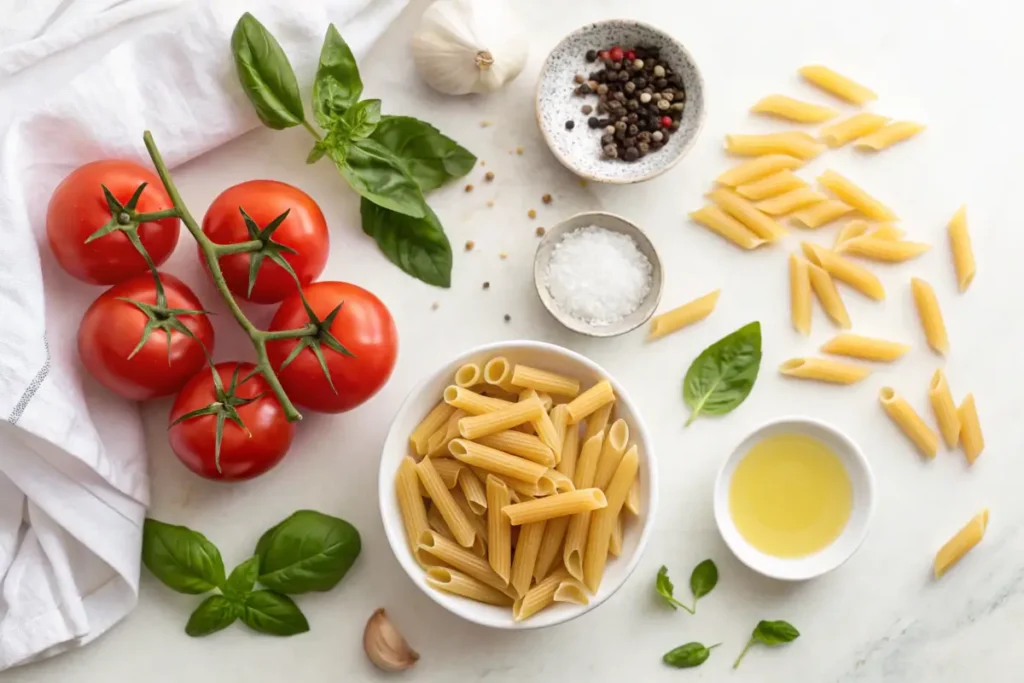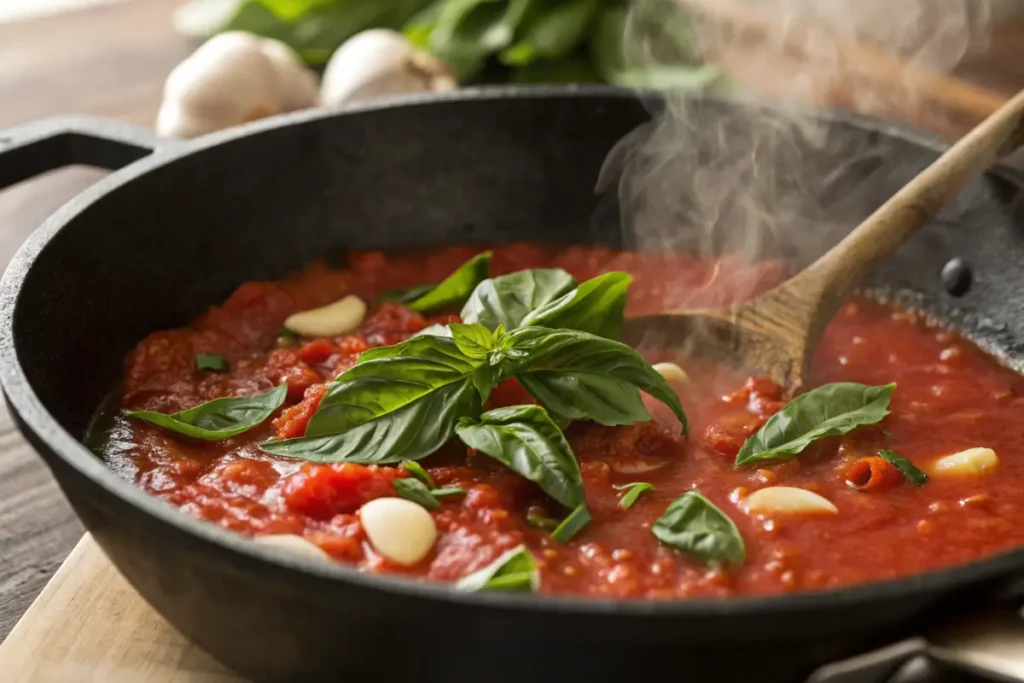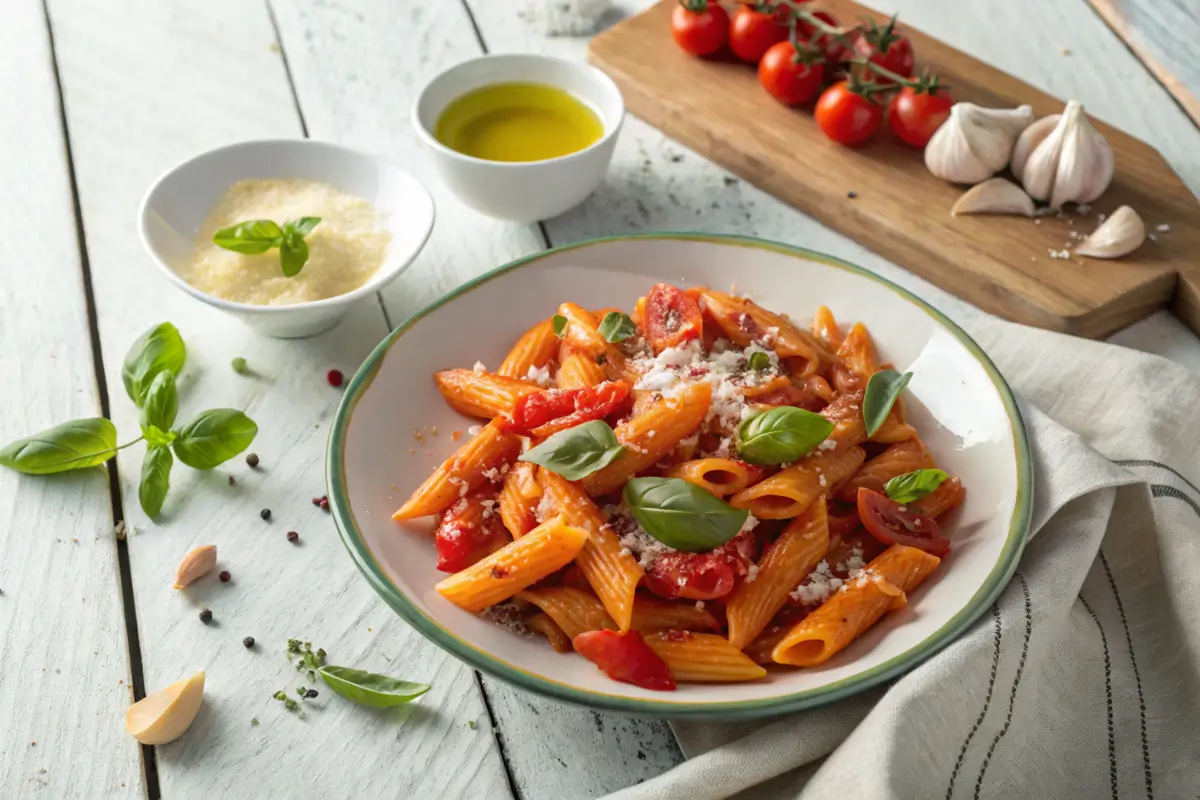When it comes to Italian comfort food, penne pomodoro stands out as a timeless classic. Simple, fresh, and packed with flavor, this dish perfectly embodies the saying “less is more.” But there’s more to penne pomodoro than meets the eye—it’s not just about pasta and tomato sauce. From its historical roots to its role as a go-to healthy meal, this article dives deep into everything you need to know about this beloved dish.
Whether you’re looking to master the art of making the perfect pomodoro sauce, understand the difference between pomodoro and marinara, or learn how to elevate your dinner table with this Italian staple, we’ve got you covered. Let’s begin with the basics.
Introduction to Penne Pomodoro
What is Penne Pomodoro?
Penne pomodoro is a pasta dish that combines penne—tube-shaped pasta—with a simple tomato sauce. The word “pomodoro” means “tomato” in Italian, and the sauce is made with fresh tomatoes, olive oil, garlic, and basil. The charm of this dish is in its simplicity and fresh ingredients, making it a popular choice for quick dinners and special meals.
This dish is not only tasty but also very flexible. It can be adjusted to fit different diets, whether you’re vegan, vegetarian, or need a gluten-free option. Its wide appeal and easy preparation have made it a favorite in both traditional Italian cooking and modern kitchens.
The History of Pomodoro Sauce
Pomodoro sauce has its roots in 16th-century Italy, when tomatoes were first brought to Europe. At first, people were unsure about using tomatoes, but they soon became a key part of Italian cooking. By the 19th century, pomodoro sauce was an important part of Italian cuisine, loved for how it improves pasta dishes without overpowering them.
There’s a story that pomodoro sauce was first created as a quick and cheap way to feed families because it uses simple, low-cost ingredients. Over time, it became a celebrated part of cooking, with different regions of Italy adding their own special touches.
Why Penne is the Perfect Pasta for Pomodoro
Picking the right pasta matters when making penne pomodoro. Penne’s ridged surface and hollow shape make it great for holding the sauce, so every bite is full of flavor. Its structure is also strong enough to match the sauce’s richness, creating a balanced dish.
While other pastas, like spaghetti or rigatoni, can work with pomodoro sauce, penne is the best mix of texture and flavor. Its small size also makes it easy to eat, whether you’re dining alone or hosting a meal for friends.
Ingredients and Preparation
Essential Ingredients for Pomodoro Sauce

Creating an authentic penne pomodoro begins with selecting the best ingredients. The star of the dish is, of course, the pomodoro sauce. Here’s what you’ll need:
- Fresh tomatoes: Plum or San Marzano tomatoes work best for their rich, sweet flavor. If fresh tomatoes aren’t available, high-quality canned tomatoes are a great substitute.
- Olive oil: Opt for extra virgin olive oil to enhance the dish with a fruity and slightly peppery aroma.
- Garlic: Freshly minced garlic infuses the sauce with an irresistible depth of flavor.
- Basil: Fresh basil leaves are essential for their aromatic and slightly sweet taste.
- Salt and pepper: These staples balance and enhance the natural flavors of the ingredients.
Every ingredient plays a role in creating a vibrant, fresh sauce that’s the heart of this dish. The key is to keep it simple—let the natural flavors shine.
Choosing the Right Penne Pasta
Pasta choice can make or break your penne pomodoro. Penne rigate, with its ridged texture, holds the sauce beautifully, ensuring every bite bursts with flavor. If you’re feeling adventurous, experiment with whole wheat or gluten-free penne for a healthier twist.
When cooking penne, always follow the al dente rule. This ensures the pasta retains its firmness and provides the perfect contrast to the silky sauce.
Key Tips for Freshness and Flavor
Want to elevate your penne pomodoro? These tips will make a big difference:
- Use freshly harvested ingredients whenever possible. Fresh basil and ripe tomatoes add a distinct brightness to the dish.
- Don’t rush the sauce. Allow it to simmer gently so the flavors meld together.
- Save some pasta water. Adding a splash of this starchy liquid to the sauce ensures it clings perfectly to the penne.
Step-by-Step Recipe for Penne Pomodoro

How to Make Pomodoro Sauce
Start by preparing the pomodoro sauce. Heat olive oil in a large skillet over medium heat. Add minced garlic and sauté until fragrant, about 1-2 minutes. Stir in chopped tomatoes (or canned tomatoes) and cook until they break down into a chunky sauce.
Simmer the sauce on low heat, stirring occasionally, for about 20 minutes. Season with salt and pepper to taste. Just before serving, toss in fresh basil leaves to infuse the sauce with its signature aromatic flavor.
Cooking and Combining Penne and Sauce
While the sauce is simmering, cook the penne according to package instructions. Remember to reserve about a cup of pasta water before draining.
Transfer the cooked penne directly to the skillet with the sauce. Add a splash of pasta water to loosen the sauce if necessary. Toss the pasta gently until every piece is coated in the flavorful pomodoro sauce.
Variations to Elevate the Dish
Although penne pomodoro is perfect in its simplicity, there’s always room to experiment:
- Add a pinch of chili flakes for a spicy kick.
- Sprinkle freshly grated Parmesan or Pecorino cheese on top for added richness.
- Stir in sautéed vegetables like zucchini or bell peppers for a nutritious twist.
Pair this versatile dish with a crisp side salad or a loaf of crusty bread, and you have a meal that’s both satisfying and elegant.
Penne Pomodoro: A Healthy and Versatile Dish
Nutritional Benefits of Penne Pomodoro
One of the best things about penne pomodoro is its healthy mix of nutrients. This dish gives you important nutrients while staying light and filling. The tomato sauce is packed with nutrition, as tomatoes provide plenty of vitamin C, potassium, and lycopene—a powerful antioxidant that’s good for your health.
When combined with penne, especially whole wheat or gluten-free options, the dish becomes a good source of fiber. The olive oil adds healthy fats, and fresh basil gives vitamins A, K, and a fresh taste. Plus, since there’s no heavy cream or butter, the dish is low in calories, making it a great choice for people who want to eat healthy.
How to Adapt Penne Pomodoro for Dietary Needs
Penne pomodoro is very flexible, so it’s easy to change for different diets:
- Vegan: This dish is already vegan, but you can add plant-based cheese for extra flavor.
- Gluten-Free: Replace regular penne with gluten-free pasta, like brown rice or chickpea pasta.
- Low-Carb: Use zucchini noodles or shirataki noodles instead of regular pasta.
For more healthy pasta inspiration, consider browsing related recipes, like beef pasta alfredo, to discover ways to enjoy balanced, flavorful meals.
The Difference Between Pomodoro, Marinara, and Other Sauces
Pomodoro vs. Marinara: Key Differences
Although they may appear similar, pomodoro and marinara sauces have distinct characteristics. Pomodoro sauce is smoother and richer, often blended or strained for a velvety texture. It’s designed to coat pasta evenly, making it the ideal choice for dishes like penne pomodoro. Marinara, on the other hand, has a chunkier texture and a more robust flavor profile due to added ingredients like onions, oregano, and sometimes chili flakes.
Another key difference lies in the cooking process. While marinara is cooked quickly to retain its fresh and tangy flavor, pomodoro sauce is simmered longer to develop a deeper, sweeter taste.
Comparing Pomodoro to Arrabbiata and Other Tomato-Based Sauces
Pomodoro isn’t the only tomato-based sauce on the block. Arrabbiata, for example, brings a fiery twist to the table with its generous use of chili peppers. While pomodoro sauce focuses on subtlety and balance, arrabbiata caters to those who crave bold, spicy flavors.
Puttanesca, another popular tomato-based sauce, is enriched with briny ingredients like olives, capers, and anchovies. Though delicious, it’s far more complex than the clean, simple flavors of pomodoro sauce.
Understanding these distinctions allows you to appreciate the unique qualities of each sauce and choose the best fit for your meal. Whether you prefer the delicate elegance of penne pomodoro or the spicy kick of arrabbiata, there’s a tomato-based sauce for every craving.
For additional ideas on exploring Italian sauces, consider checking out other recipes on the website. They’ll help you expand your repertoire and add variety to your pasta nights!
Pairing Penne Pomodoro with Sides and Beverages
Ideal Side Dishes for Penne Pomodoro
While penne pomodoro can easily shine as a standalone meal, pairing it with complementary sides takes the experience to the next level. A crisp, refreshing salad—like an arugula and Parmesan mix with a drizzle of balsamic vinaigrette—balances the rich, tangy notes of the pomodoro sauce. Another excellent choice is garlic bread or focaccia, perfect for soaking up any leftover sauce on your plate.
For something heartier, consider a side of roasted vegetables such as zucchini, eggplant, or bell peppers. Their smoky, caramelized flavors pair beautifully with the fresh tomato and basil in penne pomodoro. Alternatively, a bowl of minestrone soup can create a comforting, wholesome meal.
Beverage Pairings: From Wine to Non-Alcoholic Options
Pairing the right drink with penne pomodoro enhances the dining experience. A medium-bodied red wine like Chianti or Sangiovese complements the tomato’s acidity and the olive oil’s richness. For white wine lovers, Pinot Grigio’s crisp notes make a refreshing contrast to the dish’s robust flavors.
Non-alcoholic options work just as well. Sparkling water with a twist of lemon cleanses the palate, while a homemade iced tea infused with basil adds a thematic touch. These drinks not only highlight the dish’s simplicity but also keep the focus on its authentic Italian essence.
Frequently Asked Questions About Penne Pomodoro
What is Pomodoro Sauce Made Of?
Pomodoro sauce is all about simplicity and quality. It typically includes fresh tomatoes, olive oil, garlic, and basil, seasoned with salt and pepper. These ingredients come together to create a vibrant, light sauce that forms the heart of penne pomodoro. The secret lies in using the freshest possible ingredients to capture the dish’s authentic flavors.
What is the Meaning of Penne Pomodoro?
The phrase penne pomodoro directly translates to “penne with tomato” in Italian. It reflects the dish’s straightforward nature: pasta paired with a basic yet flavorful tomato sauce. This simplicity is what makes it a beloved staple in Italian households and beyond.
Is Pomodoro Different from Marinara?
Yes, pomodoro and marinara are distinct sauces. While both are tomato-based, pomodoro sauce is smoother and more refined, ideal for coating pasta evenly. Marinara is chunkier and has a stronger, tangier flavor due to ingredients like onions and herbs. For pasta dishes like penne pomodoro, the smoother pomodoro sauce is preferred.
What is Penne Pomodoro Carrabba’s?
At Carrabba’s Italian Grill, penne pomodoro is featured as a classic pasta dish made with their signature pomodoro sauce. While it follows the traditional recipe, the restaurant may add its own subtle variations to cater to its menu and diners. It’s a testament to the dish’s versatility and widespread appeal.
Creative Twists to Penne Pomodoro
Adding a Protein Boost
Penne pomodoro is tasty on its own, but adding some protein can make it more filling. Grilled chicken or shrimp works well with the fresh and tangy pomodoro sauce. If you prefer a vegetarian option, you can add roasted chickpeas or small cubes of tofu for extra texture and nutrients.
You can also use ground turkey or beef to make it heartier. Cook the meat in olive oil before adding garlic and tomatoes. The rich, savory taste of the meat blends perfectly with the bright flavors of the pomodoro sauce.
Experimenting with Flavors
Feel free to get creative! Adding a little cream can make penne pomodoro smoother and richer. Or, mix in a spoonful of basil pesto to add an herby flavor. If you like a bit of spice, sprinkle in red pepper flakes or smoked paprika.
For a fun twist, try topping the pasta with crumbled feta cheese or ricotta. These cheeses give a salty and tangy taste that matches the sweetness of the sauce. Trying these small changes can keep this classic dish exciting and new.
Why Penne Pomodoro Deserves a Spot in Your Recipe Repertoire
Easy to Make, Hard to Resist
One of the best things about penne pomodoro is how simple it is to cook, even if you’re new to the kitchen. With just a few basic ingredients and some fresh ones, you can make this dish in under 30 minutes. Its simplicity makes it special—it’s proof that great food doesn’t need to be complicated.
The dish is also easy to adjust, so you can change it to match your taste or diet. Whether you’re hosting guests or having a quiet dinner, penne pomodoro is always a great choice.
A Dish Rooted in Tradition
More than just a meal, penne pomodoro is a celebration of Italian cooking traditions. Its simple recipe shows the Italian love of using fresh, high-quality ingredients. Every bite tells a story of family, heritage, and the joy of sharing meals.
By adding penne pomodoro to your recipe list, you’re not just cooking—you’re connecting with a timeless tradition. And that makes this dish extra special.

